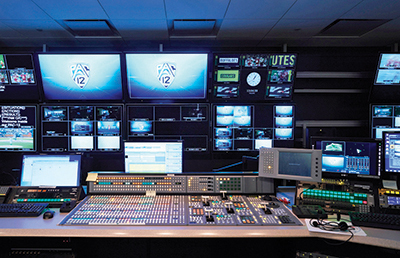Getting the Most Multiviewer for the Money

Diversified Systems installed this multiviewer wall in PAC-12 Networks’ Production Control Room last year. OTTAWA—Multiviewers—software/hardware systems that allow multiple video sources to be displayed in separate windows on a single monitor—have ended the reign of dedicated source CRTs in TV control rooms.
“Conditions in control rooms change, so multiviewers become the best solution to size, reshape or distribute the pips among large LCD screens,” said Karl Paulsen, CIO of Diversified Systems, a Kenilworth, N.J.-based systems integrator and author of TV Technology’s “Storage Technology” column. “The advantages are flexibility, cost reduction, power savings [cooling] and multiplicity.”
That said, not all multiviewers available are created equal. To buy the right one for a particular television facility—whether it’s new or part of a retrofitting project engineers need to know what qualities to look for.
MULTIVIEWERS IN ACTION
Wherever one looks, television broadcasters are installing multiviewers. In fact, “we’ve been seeing a push for multiviewers for many years now,” said Greg Doyle, Diversified Systems’ senior consulting engineer. “I first designed this technology into a facility in 2002, using the Miranda Kaleido and the Evertz MVP.”
In 2010, Comcast SportsNet Middle Atlantic in Bethesda, Md., installed two large Miranda Kaleido-X multiviewers to support monitor walls throughout its plant. The company purchased Kaleido-Xs because “we were doing an upgrade at the time to HD, and wanted a multiviewer that could handle five levels of tallies,” said Steve Weber, CSMA’s director of engineering.
At the 2013 NAB Show, Miranda will introduce its Kaleido-MX series, “a completely new platform aimed at reducing the space and power required to run multiviewers,” according to Martin Jolicoeur, Miranda’s product manager. “Compared to the Kaleido-X, the Kaleido-MX will use about half the power to perform the same functions.”
Viacom/MTV Networks recently expanded its network operations center in Hauppauge, N.Y. to support up to 80 additional standard- and high-definition SDI on-air playout chains. Broadcast Integration Services of Union City, N.J. was the integrator on the project, which saw nine Evertz MVP multiviewers installed to support six control rooms.
“We’re seeing a lot of people moving to multiviewers,” said Joseph Policastro, BIS’ senior director. “The trend started a few years ago, when the quality, power and pricing of multiviewers got better.”
BUYING THE RIGHT ONE
Miranda and other multiviewer makers such as Apantac, Evertz, Grass Valley, Harris, Matrox and Snell provide a wide range of models and capabilities for broadcasters large and small. The key for engineers is getting the right multiviewer for the job, hopefully at the right price.
The NAB Show offers an excellent opportunity to shop around for multiviewers in Las Vegas. The trick is to ask the right questions.
To borrow a phrase from Ford, “Quality is Job 1” when it comes to selecting multiviewers. This includes both the signal handling specs of the unit, and the way in which is built. But this is only the beginning: The right multiviewer must provide engineers with flexibility and scalability.
“You’ve got to be able to add more feeds and more monitors to the system, without having to take down master control to do the upgrade,” said Policastro.
As well, multiviewers must be able to “place nicely with others.” In broadcast engineering terms, this means supporting “integration with the entire routing matrix,” Paulsen said—plus having the “ability to display numerous images and resolutions without blocking, ability to expand the number of inputs and outputs without changing out the chassis, and ability to use SDI, fiber optic and DVI/HDMI inputs and outputs without penalties.”
CRT VS. LCD
Although the video displayed on LCD monitors fed by multiviewer devices is of lower quality than that shown on dedicated CRT monitors, the issue is less about the multiviewer than it is about the display technology being used, according to Doyle.
“The new LCD monitors typically used in control rooms are pretty good, but they simply don’t have the ability to correctly display color the same way a CRT did,” he said. “There is, however, a dramatic improvement in visual acuity with the increased resolutions provided by modern displays. [Still] It is important to have at least one view grade monitor in the control room for critical color analysis.”
But is it? Rick Singer, chief engineer with the U.S. State Department’s Office of Broadcast Services, isn’t so sure. He argues that since the video being broadcast most likely will be viewed on an LCD monitor, assessing signal quality using a more critical CRT is unnecessary.
“If you can’t see the issue on an LCD, why worry about it?” Singer asked. “Today, LCD is the dominant display.”
Get the TV Tech Newsletter
The professional video industry's #1 source for news, trends and product and tech information. Sign up below.
James Careless is an award-winning journalist who has written for TV Technology since the 1990s. He has covered HDTV from the days of the six competing HDTV formats that led to the 1993 Grand Alliance, and onwards through ATSC 3.0 and OTT. He also writes for Radio World, along with other publications in aerospace, defense, public safety, streaming media, plus the amusement park industry for something different.

